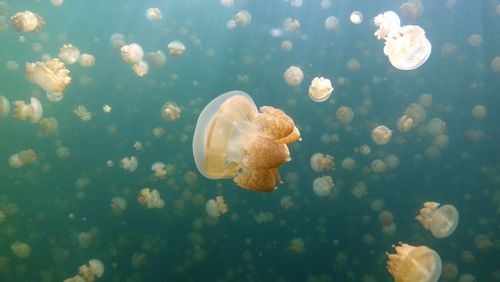

Jersey Coastguard have reported that several large jellyfish have been observed entering St Helier harbour.
They are believed to be Barrel Jellyfish which can reach up to three feet in diameter making them the largest jellyfish found in British waters. The report follows warnings in recent weeks about huge numbers of jellyfish in our waters with a number of swimmers being stung.
The Marine Conservation Society (MCS) say that the massive barrel jellyfish have appeared in record numbers in British waters for the second year in a row, whilst Guernsey has seen some of the largest smacks of Pelagia noctiluca (mauve stingers) in living memory, and the potentially dangerous Portugese Man O War has been washing up on beaches in the South West.
“Our National Jellyfish Survey suggests significant recent rises in the numbers of some jellyfish species in UK seas, most notably the barrel. The million-dollar question is why is this happening? At the moment we just don’t know,” says Dr Peter Richardson, MCS Biodiversity and Fisheries Programme Manager.
The charity says that barrel jellyfish normally make up 10% of its annual reports, but last year they made up 40%. So far in 2015, a whopping 75% of records have involved barrel jellyfish sightings.
“We know that our seas are changing through climate change, resulting in rising sea temperatures and increased ocean acidification, and we know our seas are also heavily fished. At the same time we seem to be witnessing increases in jellyfish around the UK. Is this an anomaly, a coincidence, or are the jellyfish telling us something about fundamental changes in the condition of our seas?” says Dr Richardson.
Huge ‘smacks’ of jellyfish are not a new phenomenon, with jellyfish blooms having been found in the fossil record over 500 million years. Nowadays they can have important economic and social consequences. Moon jellyfish blooms have forced the closure of UK nuclear power stations, leading to the industry investing in remote sensing mechanisms to detect increases in jellyfish near power plants. In the UK large blooms of mauve stinger jellyfish have wiped out salmon stocks in fish farms, while the same species regularly closes down bathing beaches in the Mediterranean due to the animal’s painful sting.
The Jersey Coastguard have said that we shouldn’t be alarmed as so far none of the large jellyfish seen in St Helier harbour have reached three feet.
However, comments on Facebook indicate that the ‘smacks’ of jellies around our coast are continuing. With people saying they’ve seen them at Bouley Bay, St Brelades, St Catherines and Gorey athough these are unlikely to be the Barrel variety. One Facebook user said "West of corbiere 7 this morning few miles out was like a blanket of purple ones doing the pots they sting like mad"
It's these 'mauve stingers' which reportedly closed several beaches to bathers on Spain's Costa Blanca a few years ago when swarms of them washed up.
The Marine Conservation Society urges the public to report their jellyfish sightings online at www.mcsuk.org, but urges caution, suggesting people look at, but don’t touch jellyfish because their stings can range from mild to very painful.
UK JELLYFISH IN 2015 AT A GLANCE.
Barrel jellyfish: Reported throughout the year all around the UK, but most 2015 reports from South and SW England. 75% of records this year have involved barrel jellyfish.
Moon jellyfish: Started to appear in May, by July were reported all around the UK
Blue jellyfish: Started to appear in May, by July were reported all around the UK
Compass jellyfish: Started to appear in June, with most reports in July from South West England, South West Wales and North West England
Lion’s mane: Started to appear in May, by July were reported all around Scotland, Northern Ireland and Wales.
Portuguese Man o War: About 30 reports from Devon and Cornwall in July
Mauve stinger: Unprecedented numbers recorded off Guernsey in July
By the Wind Sailor: Several reports from SW England in January, then a few in July
Comments
Comments on this story express the views of the commentator only, not Bailiwick Publishing. We are unable to guarantee the accuracy of any of those comments.